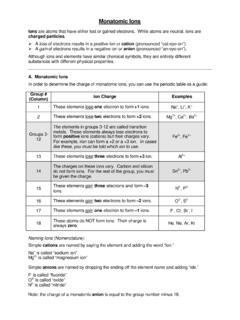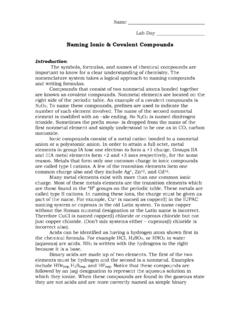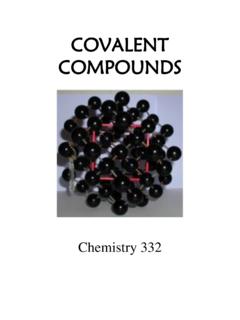Transcription of chap 19 no 4 - cstephenmurray.com
1 Ch. 19:4 Name: _____ Period: _____ Copyright 2003, C. Stephen Murray naming Compounds What s it Made of? Metal and non-metal 2 non-metals 3 or more elements polyatomic compound covalent compound ionic compound USE - IDE ENDING (NO PREFIXES!) Name the metal and non-metal and change the ending to ide . USE GREEK PREFIXES Put prefixes in front of element names to tell how many atoms are there. Don t use mono for first name, but always for second name. CHECK THE CHART BELOW (NO PREFIXES!) Use the names on the chart. If the polyatomic ion is the cation end the second name with -ide . Li2S Metal and non-metal ionic Lithium Sulfide (not dilithium sulfide no prefixes for ionic compounds) N2O4 2 non-metals covalent (di =2 and tetra =4) Dinitrogen tetroxide NaNO3 3 elements polyatomic Check chart (see below) Na - sodium NO3 - nitrate (on chart) Sodium nitrate Polyatomic Ions Oxidation # Name Formula 1+ ammonium NH4+ 1- acetate C2H3O2- 2- carbonate CO32- 2- chromate CrO42- 1- hydrogen carbonate HCO31- 1+ hydronium H3O+ 1- hydroxide OH1- 1- nitrate NO31- 2- peroxide O22- 3- phosphate PO43- 2- sulfate SO42- 2- sulfite SO32- Greek Prefixes Mono - 1 Di 2 Tri 3 Tetra 4 Penta 5 Hexa 6 Hepta 7 Octa 8 Nona 9 Deca 10 Exception O2 is peroxide and can make polyatomic com-pounds with only 2 ele-ments!
2 O2 with a non-metal is dioxide. O2 with a metal OR Hydrogen (acting as a metal) is peroxide. Why are ionic compounds so easy to name? Because most ionic com-pounds can only form one way, using the oxidation numbers. In covalent compounds, though, non-metals can sometimes combine in multiple ways (carbon monoxide; carbon dioxide). So, covalent compounds use prefixes. How to remember prefixes: Monorail one rail train Monocle glasses for one eye; single lens (Colonel Klink). Dilemma struggle between 2 choices. Tricycle 3 wheels Pentagon 5 five sided military building in Washington, Octopus 8 legs Decade 10 years Transition Metals Can Have More Than One Oxidation Number Iron (II) has an oxidation number of 2+ Iron (III) has an oxidation number of 3+. When naming them you must specify WHICH ONE. FeO Iron (II) oxide Fe2O3 Iron (III) oxide How to use this chart Determine what the compound is made of and follow the arrows.
3 The chart will tell you how to name the compound . Ch. 19:4 Name: _____ Period: _____ Copyright 2003, C. Stephen Murray Use the Polyatomic Ion Chart on the front of the worksheet to name these Polyatomic Ions: HCO31- SO42- O22- SO32- NO31- NH4+ CrO42- OH1- PO43- CO32- Hydrogen carbonate _____ _____ _____ _____ _____ _____ _____ _____ _____ Metal or Non-metal? Ionic or covalent ? Iron Oxide Ionic Barium Chloride _____ Carbon Dioxide _____ Magnesium Oxide _____ Aluminum Fluoride _____ Nitrogen Tribromide _____ Chromium Fluoride _____ Potassium Oxide _____ M N Name These Ionic Compounds MgF2 Magnesium Fluor-ide Li2O Lithium Ox- _____ NaCl Sodium Chlor- _____ K2O Potassium Ox-_____ CaS _____ Sulf- _____ BeI2 _____ Iod-_____ AlBr3 _____ Brom- _____ CaF2 _____ MgO _____ LiCl _____ Classify and Name These Compounds 1.
4 BaCl2 Ionic__ Barium chloride _ 2. CO _____ _____ 3. Ag2O _____ _____ 4. K2SO4 _____ _____ 5. MgBr2 _____ _____ 6. SO3 _____ _____ 7. P2O4 _____ _____ 8. Be(CrO4) _____ _____ 9. LiF _____ _____ 11. CO2 _____ _____ 12. OF2 _____ _____ Ionic, covalent , or Polyatomic Name Define these Greek Prefixes Penta = _____ Nona = _____ Mono = _____ Octa = _____ Tri = _____ Tetra = _____ Hexa = _____ Hepta = _____ Deca = _____ Di = _____ 1. CO2 2. C2O4 3. C3O5 4. CO 5. C2O 6. CO8 A. Carbon monoxide B. Carbon dioxide C. Dicarbon monoxide D. Tricarbon pentoxide E. Dicarbon tetroxide F. Carbon octoxide Si2O3 Disilicon _____oxide N3Cl4 _____nitrogen tetrachloride SO2 Sulfur _____oxide PO5 Phosphorous _____ox____ S2F4 ____sulfur _____fluor____ Name These covalent Compounds Name these Polyatomic Compounds (Remember no prefixes!)
5 CaSO4 Calcium _____ K2CO3 _____ carbonate CuNO3 Copper (I) _____ NH4Cl _____ chloride Mg(NO3)2 Magnesium _____ K3PO4 Potassium _____ Li2(CrO4) Lithium _____ Mg(OH)2 M_____ H_____ Al(PO4) A_____ P_____ K(NO3) _____ _____ Ca2SO3 _____ _____









